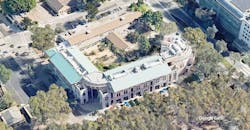UC San Diego gets $39 million grant for renewable energy testbed
The University of California, San Diego, has been awarded a $39 million grant to build a testbed to help universities, utilities and industry leaders gain a better understanding of how to integrate renewable energy resources into the power grid.
The university says in a news release that the grant from the National Science Foundation will study how to integrate distributed energy sources such as solar panels, wind turbines, smart buildings and electric vehicle batteries into the power grid.
The goal is to make the testbed available to outside research teams and industry by 2025.
The major driver for the project is the need to decarbonize the electrical grid, protect it from cybersecurity attacks and make it more resilient.
“We will be replicating the entire California power grid on one campus,” says Jan Kleissl, a professor in the Department of Mechanical and Aerospace Engineering at UC San Diego and the project’s principal investigator.
The creation of the testbed, DERConnect, addresses a national need for large-scale testing capabilities across universities, national labs, industry, utility companies and Independent System Operators to validate future technologies for autonomous energy grids in real-word scenarios.
Most utilities struggle with the fact that renewable and distributed energy sources are not as stable as traditional sources, such as natural-gas power plants. Solar panel output depends on the weather, for example, as do wind turbines. At the other end of the grid, electric vehicles need charging for only a certain amount of time every day, and when not in use could be used as temporary batteries to store energy from renewables.
As a result, although the number and diversity of distributed energy resources on the power grid is rapidly expanding, the adoption of these resources for power-grid balancing is hindered by concerns about safety, reliability and cost.
“This created the classic ‘chicken-and-egg’ situation, where the economics and impact of distributed energy resources cannot be demonstrated because there are too few of them due to limited buy-in from Independent System Operators, and other practical concerns,” Kleissl says.
Offering utilities, researchers, industry and other entities a testbed with real-world communications challenges is essential to solve these problems and develop new distributed control theories, algorithms, and applications.
The envisioned testbed is built upon a number of technical innovations at UC San Diego that create a microgrid encompassing distributed energy resources, including energy storage, electrical vehicles and independent electrical and thermal systems in buildings.
“The ultimate goal of any grid is reliability, and it is a top concern at UC San Diego, as we must constantly power medical centers and major research facilities,” says Gary Matthews, Vice Chancellor of Resource Management and Planning. “The ability to interact with buildings and change their energy profile intelligently both enhances grid stability and saves a tremendous amount of energy.”
DERConnect will include more than 2,500 distributed energy resources, or DERs, on the campus’ microgrid, with its fuel cell and solar panels, a dozen classroom and office buildings, as well as 300 charging stations for electric vehicles. It will also entail the construction of a new energy storage testing facility on the East Campus.
An upgrade to the microgrid will give researchers real time control over heating, ventilation and air conditioning systems, lighting, solar panels, battery storage and EVs. The testbed’s control center will be housed in Robinson Hall on the UC San Diego campus, which will be turned into a fully controllable building that can be disconnected from the campus’ grid at any time.
The bulk of the construction will take place this coming academic year. Researchers hope to be able to begin testing their equipment in 2022.
